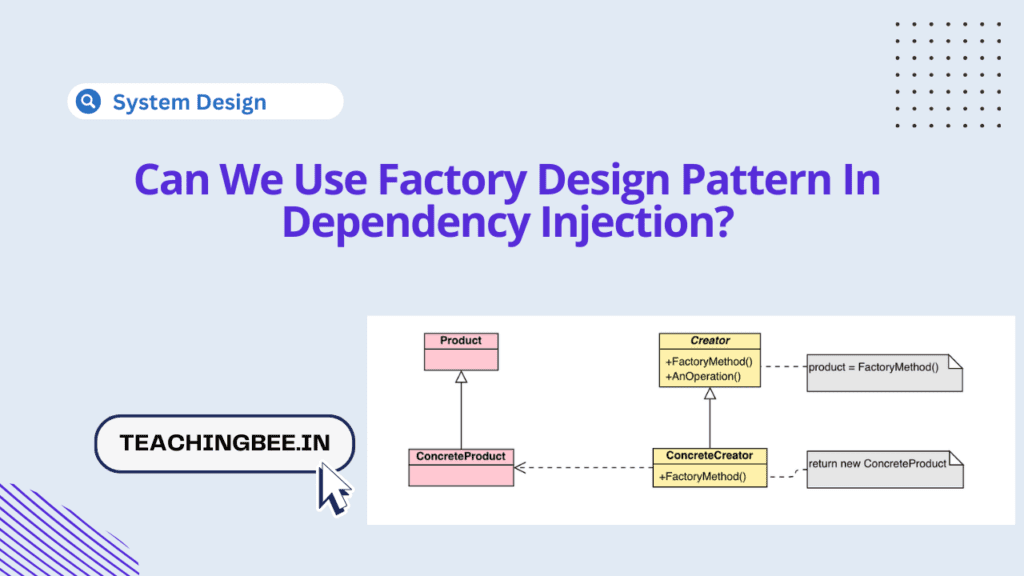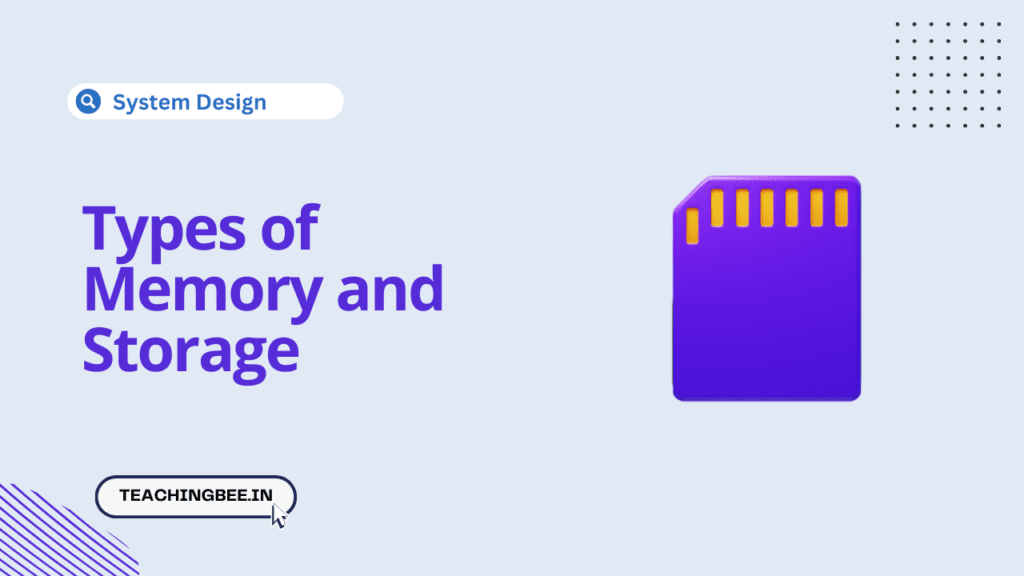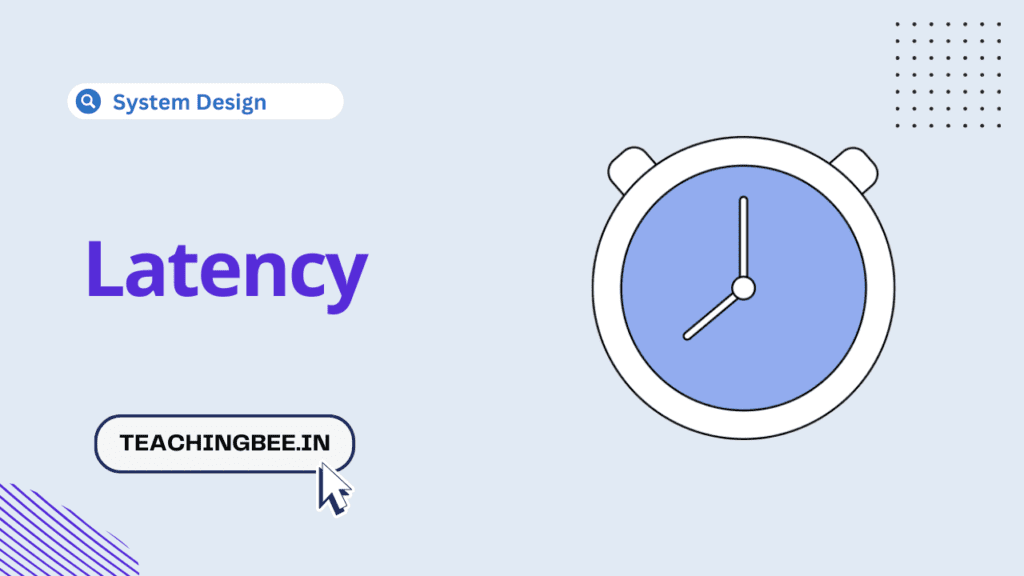Table of Contents
ToggleDependency Injection (DI) is a powerful software design pattern used to achieve loose coupling between classes and their dependencies. It allows for the inversion of control, where components are provided with their dependencies rather than creating them internally.
While DI itself is powerful, combining it with other design patterns can further enhance flexibility and maintainability in your codebase. One such combination is using the Factory Design Pattern alongside Dependency Injection.
Can We Use Factory Design Pattern In Dependency Injection?
Yes, the Factory Design Pattern can be utilized in Dependency Injection to dynamically create and provide instances of dependencies to classes, enhancing flexibility and decoupling in the system.
So, let’s see How can we use Factory Design Pattern In Dependency Injection?
Understanding Dependency Injection (DI)
Before delving into the integration of the Factory Design Pattern with Dependency Injection, let’s briefly revisit what Dependency Injection is and how it works.
In DI, rather than classes creating instances of their dependencies directly, these dependencies are provided to the class from an external source, typically through constructor injection, setter injection, or interface injection. This approach makes classes more modular, testable, and easier to maintain as it promotes a separation of concerns.
Let’s see example of Dependency Injection (DI) in Java, focusing on constructor injection:
// Interface representing the Notification Service
public interface NotificationService {
void sendNotification(String message);
}
// Concrete implementation of Email Notification Service
public class EmailNotificationService implements NotificationService {
@Override
public void sendNotification(String message) {
// Logic for sending email notification
System.out.println("Email notification sent: " + message);
}
}
// Client class using Dependency Injection through constructor
public class Client {
private final NotificationService notificationService;
// Constructor injection
public Client(NotificationService notificationService) {
this.notificationService = notificationService;
}
public void doSomething() {
// Business logic
notificationService.sendNotification("Hello, world!");
}
public static void main(String[] args) {
// Create instance of EmailNotificationService
NotificationService emailNotificationService = new EmailNotificationService();
// Inject the notification service into the client through constructor
Client client = new Client(emailNotificationService);
// Use the client
client.doSomething();
}
}In this example:
- We define an interface
NotificationServicewhich represents a notification service. - We implement this interface with
EmailNotificationService, which sends notifications via email. - The
Clientclass represents a client that uses a notification service to perform some action. - Instead of creating an instance of
EmailNotificationServicedirectly insideClient, we pass it as a parameter toClient‘s constructor. This is known as constructor injection. - In the
mainmethod, we create an instance ofEmailNotificationServiceand inject it into theClientobject.
This approach promotes loose coupling between Client and EmailNotificationService, making it easier to change or extend the notification service in the future without modifying the Client class. It also makes the code more testable, as we can easily mock or substitute different implementations of NotificationService for testing purposes.
The Factory Design Pattern
The Factory Design Pattern is a creational pattern that provides an interface for creating objects in a superclass but allows subclasses to alter the type of objects that will be created. This pattern is useful when the creation of an object is complex, involves conditional logic, or needs to be delegated to subclasses.
How Can We Use Factory Design Pattern In Dependency Injection?
One common scenario where the Factory Design Pattern complements Dependency Injection is when the creation of objects involves some decision-making logic based on runtime conditions. Let’s illustrate this with an example:
Suppose we have an interface NotificationService with multiple implementations such as EmailNotificationService and SMSSNotificationService. Depending on the runtime configuration or user preferences, we need to decide which implementation to use.
Implementation in Java
// Interface for Notification Service
public interface NotificationService {
void sendNotification(String message);
}
// Concrete implementation of Email Notification Service
public class EmailNotificationService implements NotificationService {
@Override
public void sendNotification(String message) {
// Logic for sending email notification
System.out.println("Email notification sent: " + message);
}
}
// Concrete implementation of SMS Notification Service
public class SMSNotificationService implements NotificationService {
@Override
public void sendNotification(String message) {
// Logic for sending SMS notification
System.out.println("SMS notification sent: " + message);
}
}
// Factory class for creating instances of Notification Service
public class NotificationServiceFactory {
public static NotificationService createNotificationService(String type) {
switch (type) {
case "email":
return new EmailNotificationService();
case "sms":
return new SMSNotificationService();
default:
throw new IllegalArgumentException("Invalid notification type: " + type);
}
}
}
// Client class using Dependency Injection with Factory Pattern
public class Client {
private final NotificationService notificationService;
// Constructor injection using Factory Pattern
public Client(NotificationService notificationService) {
this.notificationService = notificationService;
}
public void doSomething() {
// Business logic
notificationService.sendNotification("Hello, world!");
}
public static void main(String[] args) {
// Create notification service using Factory
NotificationService emailNotificationService = NotificationServiceFactory.createNotificationService("email");
// Inject the notification service into the client
Client client = new Client(emailNotificationService);
// Use the client
client.doSomething();
}
}In this example, we have an interface NotificationService representing various notification mechanisms. We then have concrete implementations for email and SMS notification services. The NotificationServiceFactory class provides a method to create instances of these services based on a provided type.
Finally, in the Client class, we inject the desired NotificationService implementation using the factory method, thus achieving Dependency Injection with the Factory Design Pattern.
Conclusion
Combining the Factory Design Pattern with Dependency Injection can lead to more flexible and maintainable code, especially in scenarios where object creation involves decision-making logic. By decoupling the creation of objects from their usage, we promote modular and testable code, ultimately leading to more robust software systems.
Similar Posts
How Factory Design Pattern Is Used in Spring Boot?
How to Apply Factory Design Pattern for Payment System
What Is the Difference Between Factory and Abstract Factory Design Patterns?
When to Use Factory Design Pattern in Java?
FAQ
What is the main goal of the factory design pattern?
The main goal of the factory design pattern is to provide an interface for creating objects in a superclass, but allow subclasses to alter the type of objects that will be created. It promotes loose coupling by abstracting the object creation process from the client code.
What is factory design pattern with real time example?
A real-time example of the factory design pattern could be a software application that produces different types of documents, such as reports, spreadsheets, and presentations. Instead of having the client code directly instantiate each type of document (e.g., Report, Spreadsheet, Presentation), a DocumentFactory can be used. The DocumentFactory provides methods for creating different types of documents based on user input or other factors. This way, the client code only interacts with the factory to obtain instances of documents, without being concerned about their specific implementation details.
What are the types of factory pattern?
There are several variations of the factory pattern, including:
- Simple Factory: This is the most basic form of factory pattern where a factory class has methods for creating objects without exposing the instantiation logic to the client.
- Factory Method: In this pattern, a superclass provides an interface for creating objects, but allows subclasses to override the instantiation process to provide different implementations of the created objects.
- Abstract Factory: This pattern provides an interface for creating families of related or dependent objects without specifying their concrete classes. It defines a set of methods, each of which returns a different abstract product.
What is the benefit of factory pattern?
The benefits of using the factory pattern include:
- Encapsulation: It encapsulates the object creation process, hiding the implementation details of object creation from the client code.
- Flexibility: It allows for easy extension and modification of the object creation process, enabling the addition of new types of objects without modifying existing client code.
- Promotes Loose Coupling: It promotes loose coupling between the client code and the created objects, as the client code only interacts with the factory interface, not with the concrete classes directly.
- Centralized Control: It provides a centralized place (the factory) to manage the creation of objects, making it easier to maintain and refactor the code.




